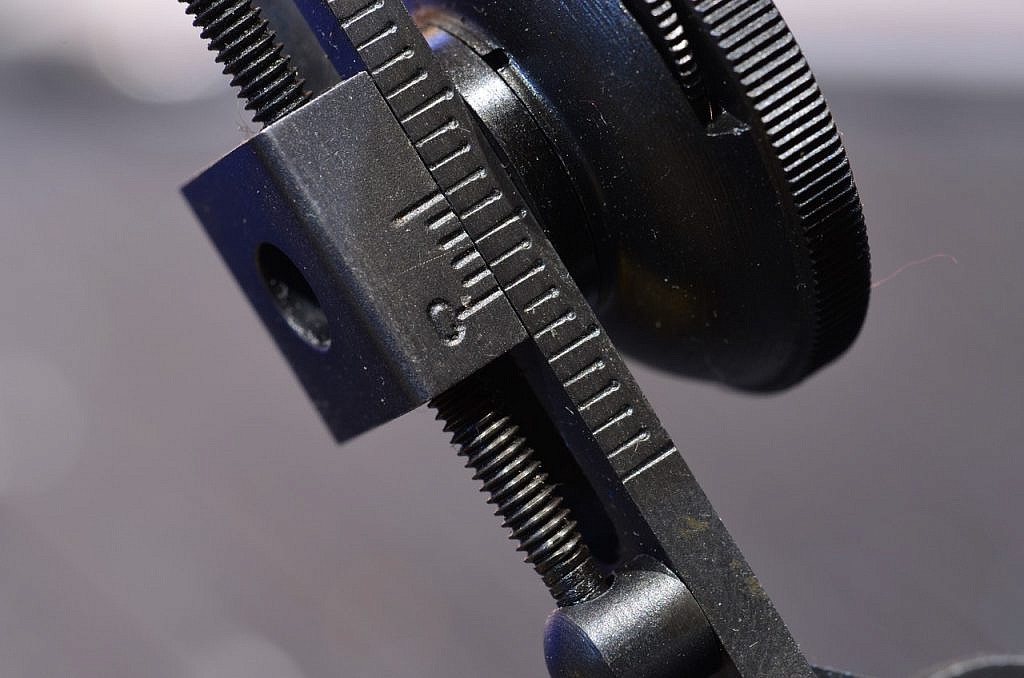
by Terry Wieland
Let’s start with a confession: I do not know how to use an abacus. A few math types have tried to teach me, to no avail.
And that’s not all. Among the other artifacts of ancient technology that have eluded me, anything involving a Vernier scale is a mystery. Although I spent a couple of pointless high school years in technical courses that required the use of a slide rule, its actual, practical, use was beyond me.
Measuring instruments? I have a dial caliper I’ve mastered, mainly because it has a dial, but a micrometer is a continuing challenge. I have to re-learn what the marks mean each and every time I pick it up. I could buy a new, digital caliper and micrometer, but somehow that seems like surrender.

Which brings me to the point of this. As a devotee of older rifles—rifles made before 1914, in many cases—I have had to learn to use the extraordinarily sophisticated sights that were made for both target and long-range hunting rifles in the years before optical sights became durable enough for general use.
Broadly speaking, there are two types of tang-mounted aperture sights. One is referred to as “micrometer” style, the other uses a Vernier scale. The former is simpler, since adjustment consists mostly of counting how many lines up or down, or in some cases, counting “clicks.” The latter is more complicated but more exact, with much finer graduations of adjustment. Generally, you find micrometer adjustments on hunting sights, such as the famous Lyman, and Vernier scales on target models.
Within those broad categories, the range of variations is vast. Entire books could be written, and have been, about the sights invented by German target shooters in the 1800s, some of which achieved remarkable sophistication combined with mind-boggling complexity. Alas, there are very few surviving instruction sheets for these, if any existed in the first place.

In America, increasingly elaborate sights were developed between 1880 and 1900. Some were developed by gunmakers, but the best were invented by advanced shooters who also happened to have a mechanical bent. Harry Pope and Milton Farrow both invented rifle sights, and both are highly regarded technically, although neither has been manufactured in the modern era.
Ned Roberts rated the Farrow the best of all, followed by the Soule and the Pope. The Soule, invented by J.W. Soule of Boston and introduced in 1888, has a Vernier scale for elevation and a micrometer windage adjustment. It is now manufactured in various configurations by two companies. The one I am most familiar with is Lee Shaver, of Lamar, Missouri. Lee is a champion long-range black-powder riflemen as well as an accomplished machinist and gunmaker. I have Shaver sights on three or four different rifles.


Last week, I had one of these at the range—a Stevens Model 49 “Walnut Hill”—in .22 Long Rifle. A friend asked to shoot it. I introduced him to the sight and the double set-trigger, pointed out the black bull’s-eye at 75 yards, and left him to it. Although a riflemen of long experience, this setup was new to him and he had considerable difficulty with it, even though adjusting the sight was not even part of the deal.
The sights consisted of a Soule-type aperture tang sight with a Hadley eyecup, which allows varying the diameter of the aperture. The front was a globe-type, with an interchangeable aperture that appears just slightly bigger than the bull. Through the sights, ideally, the bull appears centered in the front-sight aperture, with a narrow ring of white target around it.
Here, however, is the trick: You want the bull centered in the aperture with enough white to see clearly, and then the front aperture centered in the rear-sight aperture with enough room around it to see that you are on the correct target. Hence all the adjustments and variations available. A lot depends on the size of the black bullseye, its distance from the rifle, the distance between the sights on the rifle, and the distance of the shooter’s eye from the tang sight.
Add to this the small spirit level attached to the front sight to prevent canting, and you have a lot of things to get exactly right if you are to put your bullets consistently into the X-ring. This is tricky enough, sighting in with sand bags, and infinitely more difficult to do shooting offhand, as the Stevens was intended to be.
Consider that the Vernier scale was invented almost 400 years ago, that the sights we are discussing were invented 130 years ago, and that some can be adjusted to 1/1,000th (that’s one thousandth of an inch) and it puts our smug arrogance about modern technology into perspective. Most modern riflescopes have click adjustments that move the point of impact one minute of angle (MOA), or a quarter-inch, at 100 yards.
The old tang sights can move the point of impact a few hundredths of an inch—if, that is, you can figure out how to do it. I’m working on it.
Shooting editor Wieland’s courses in machine shop, drafting, woodworking, electricity and electronics taught him only that he should avoid a career in any of the above.
